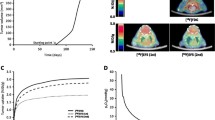Abstract
Purpose
The aim of this study was to demonstrate the ability to use human clinical positron emission tomography/computed tomography (PET/CT) to detect and investigate head and neck cancers chemically induced by 4-nitroquinoline-1-oxide (4-NQO) in a rat model.
Study design
The study design was prospective animal research.
Procedures
A head and neck squamous cell carcinoma was established in 20 immunocompetent rats, who drank a 4-NQO solution during 16 weeks. 2-Deoxy-2-[F-18]fluoro-d-glucose (FDG)-PET/CT was performed for five of them, 34 weeks after the start of the experiment to characterize the tumors. A day following the FDG-PET/CT, rats were euthanized and pathological features were evaluated by hematoxylin–eosin staining.
Results
All rats had head and neck tumor at various locations at 34 weeks. Among the five rats selected for having FDG-PET/CT, the clinical examination detected exophytic tumors grown in the oral cavity for three of them (one on the inferior lip, one on the hard palate, and one on the internal side of the cheek). FDG-PET/CT confirmed the presence of those tumors and detected ones located on the base of tongue for three of them. Tumor extensions were characterized and tumor metabolic volumes were measured. The smallest lesion detected measured 3 × 3 × 4 mm. Pathologic examination using hematoxylin–eosin staining confirmed squamous cell carcinoma.
Conclusions
This study demonstrated that FDG-PET/CT is a feasible examination to detect occult primary tumors in rat models. It is useful to follow tumor progression and evaluate therapeutics efficacy.






Similar content being viewed by others
References
Hawkins BL, Heniford BW, Ackermann DM et al (1994) 4NQO carcinogenesis: a mouse model of oral cavity squamous cell carcinoma. Head Neck 16:424–432
Nauta JM, Roodenburg JL, Nikkels PG et al (1996) Epithelial dysplasia and squamous cell carcinoma of the Wistar rat palatal mucosa: 4NQO model. Head Neck 18:441–449
Kanojia D, Vaidya MM (2006) 4-Nitroquinoline-1-oxide induced experimental oral carcinogenesis. Oral Oncol 42:655–667
Tang XH, Knudsen B, Bemis D et al (2004) Oral cavity and esophageal carcinogenesis modeled in carcinogen-treated mice. Clin Cancer Res 10:301–313
Ohne M, Satoh T, Yamada S et al (1985) Experimental tongue carcinoma of rats induced by oral administration of 4-nitroquinoline 1-oxide (4NQO) in drinking water. Oral Surg Oral Med Oral Pathol 59:600–607
Ribeiro DA, Fávero Salvadori DM, da Silva RN et al (2004) Genomic instability in non-neoplastic oral mucosa cells can predict risk during 4-nitroquinoline 1-oxide-induced rat tongue carcinogenesis. Oral Oncol 40:910–915
Wallenius K, Lekholm U (1973) Oral cancer in rats induced by the water-soluble carcinogen 4-nitrochinoline N-oxide. Odontol Revy 24:39–48
Bao A, Phillips WT, Goins B et al (2006) Setup and characterization of a human head and neck squamous cell carcinoma xenograft model in nude rats. Otolaryngol Head Neck Surg 135:853–857
Niwa S, Ueno S, Shirasu R (2001) Alteration of pRb expression in the development of rat tongue carcinoma induced by 4-nitroquinoline 1-oxide. Oral Oncol 37:579–585
Okazaki Y, Tanaka Y, Tonogi M et al (2002) Investigation of environmental factors for diagnosing malignant potential in oral epithelial dysplasia. Oral Oncol 38:562–573
Tatsumi M, Nakamoto Y, Traughber B et al (2003) Initial experience in small animal tumor imaging with a clinical positron emission tomography/computed tomography scanner using 2-[F-18]fluoro-2-deoxy-d-glucose. Cancer Res 63:6252–6257
Monteil J, Dutour A, Akla B et al (2005) In vivo follow-up of rat tumor models with 2-deoxy-2-[F-18]fluoro-d-glucose/dual-head coincidence gamma camera imaging. Mol Imaging Biol 7:220–228
Dutour A, Monteil J, Paraf F et al (2005) Endostatin cDNA/cationic liposome complexes as a promising therapy to prevent lung metastases in osteosarcoma: study in a human-like rat orthotopic tumor. Mol Ther 11:311–319
Kostakoglu L, Goldsmith SJ (2004) PET in the assessment of therapy response in patients with carcinoma of the head and neck and of the esophagus. J Nucl Med 45:56–68
Author information
Authors and Affiliations
Corresponding author
Rights and permissions
About this article
Cite this article
Aubry, K., Shao, Z., Monteil, J. et al. FDG-PET/CT of Head and Neck Squamous Cell Carcinoma in a Rat Model. Mol Imaging Biol 11, 88–93 (2009). https://doi.org/10.1007/s11307-008-0183-y
Received:
Revised:
Accepted:
Published:
Issue Date:
DOI: https://doi.org/10.1007/s11307-008-0183-y




